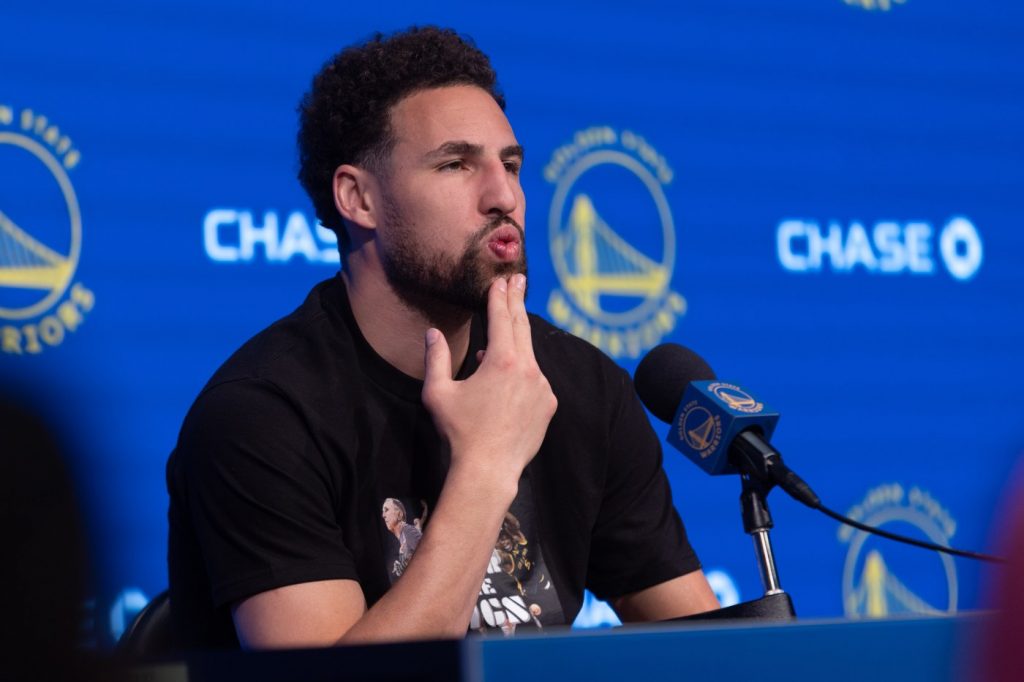The NBA playoffs are still going strong, but the first offseason domino fell for the Warriors on Sunday.
As expected, the ping-pong balls didn’t bounce the Warriors’ way, sending their first-round pick to Portland. The result, which was a 97% certainty entering the lottery, cements what was technically a loose end. The front office doesn’t need to break open any binders for contingency plans starting with what to do with a top-four pick.
Because they missed the playoffs, the Warriors now have a head start on offseason planning. Some important dates are already creeping up on them.
Here’s a guide to how the Warriors will have to navigate this offseason:
Contract decisions
First on the calendar are the contracts with options.
Gary Payton II has a player option for $9.1 million, and he’ll have to decide before June 19.
Opting in makes sense for the guard who has had difficulties staying on the court, but Payton expressed interest in his exit interview for working out a longer-term deal. That could be mutually beneficial; if he and the Warriors could agree to, say, a two- or three-year deal worth $5 million per year, Payton would get long-term security and more overall money while smoothing out his cap hit for the team.
The Warriors have already exercised Jonathan Kuminga and Moses Moody’s fourth-year team options, so they’re on the books.
The Draft: June 27
The Warriors’ only pick is the 52nd selection, so it’s unlikely the team will add an impact rookie. But it’s not impossible: Last year, Mike Dunleavy Jr.’s front office nabbed Trayce Jackson-Davis with the 57th pick, and he looks like he’ll be a rotation player for a long time.
There are a couple of ramifications from losing the 14th overall pick. First, the Warriors officially won’t be adding a relatively hefty rookie-scale salary (up to $10.5 million) to their payroll. Also, not having a pick this year means that Golden State can trade its 2026 and 2028 picks while staying in accordance with the Stepien Rule.
Interestingly, the Warriors will have to make a decision on Kevon Looney on June 24, a few days before the draft. Looney’s contract is guaranteed for $3 million, but he will earn $8 million if the Warriors bring him back. Like with Payton, there could be a mutual interest in restructuring things.
Klay Thompson and the free agents
The biggest question Golden State faces this summer is how to handle Thompson’s pending free agency.
Thompson, 34, remains one of the best volume 3-point shooters in the league. His defensive skills have diminished — understandably, given his pair of significant leg injuries — and Steve Kerr hinted at a possible permanent bench role going forward in his exit interview.
Thompson reportedly declined the Warriors’ two-year, $48 million extension offer before last season. If anything, the Warriors will likely be inclined to offer him less than that now.
Other teams will be interested in Thompson and will be able to outbid Golden State. Teams like the Magic, Cavaliers, 76ers, Spurs and Thunder need shooting and either have or can create cap space.
The ball will be in Thompson’s court. How important is staying with one organization to him?
Dario Saric, also an unrestricted free agent, doesn’t have much of a future as a Warrior. Lester Quinones and Usman Garuba are restricted free agents.
Free agency negotiating officially begins July 1.
Assets
The easiest avenue for the Warriors to accomplish some of their objectives — getting more athletic and adding a secondary scorer next to Steph Curry — is via a trade.
The players teams will call most about are Jonathan Kuminga and, to a lesser degree, Moses Moody. But they, at least hypothetically, are key to the Warriors’ goals of youth and athleticism.
It’d also be easy to see Andrew Wiggins fit on a team in need of a wing like Cleveland or Philadelphia, but his value has plummeted since reaching its apex in 2022. Wiggins has three years and $84 million remaining on a manageable contract.
The Warriors could also move Chris Paul. Before June 28, the team must either opt into Paul’s $30 million for 2024-25 or waive him for nothing. The latter frees up significant cap space, while the former makes it easier for them to match salaries in a trade. Cutting Paul appears more sensible unless the club has a trade lined up for the veteran point guard.
Related Articles
Without lottery luck, Warriors lose first-round pick
DIMES: The Warriors’ 2024 Draft Lottery chances and conventional wisdom
Steph Curry won’t defend Tahoe golf title due to Olympic commitment
Kurtenbach: Klay Thompson is flirting with other teams. The Warriors can’t pretend he’s bluffing
Golden State WNBA franchise finds its leader, who is already talking titles alongside Lacob
Cap space
Projecting Golden State’s cap situation is mostly futile before it makes decisions on Thompson and Paul.
Owner Joe Lacob has said that the Warriors — which was above the second apron in 2023-24 — plan to not just duck out of the second apron, but out of the luxury tax entirely. That’s entirely possible, and avoiding punitive restrictions of being a repeater tax team could pay dividends.
The salary cap for 2024-25 is estimated at $141 million. The luxury tax limit is $171 million.
If the Warriors let Thompson walk and cut Paul, they’d have roughly $144 million in salary on the books. Depending on other variables — like Looney and Payton — the Warriors could get under the salary cap altogether.
But there’s no realistic path for Golden State to create enough space for a top-tiered free agent who’d demand a max contract, so it would have to rely on things like the mid-level exception (the non-taxpayer mid-level is set at about $13 million). Thompson is almost certainly more valuable than a veteran Golden State could sign with that maneuver.
Shaving payroll and improving the roster don’t typically go hand-in-hand.


